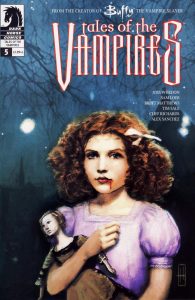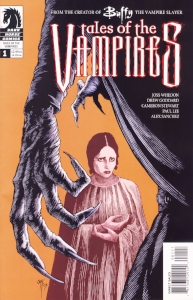Often when a comic book series ends, that final issue will sit in its slot on the racks for a long time afterward, since there is no next issue to replace it. My enduring memory of “Tales of the Vampires” (December 2003-April 2004) is seeing Issue 5 on the rack for a year or so. It was the last issue of Dark Horse’s original “Buffy” run, leaving a three-year gap before Season 8 began in 2007. (It wasn’t a total dark age: There were “Buffy” novels throughout this time, and IDW’s “Angel” comics started in 2005.)
While many readers felt the “Buffy” line was ending too soon, after my re-read I have to admit it went out on a high note. Joss Whedon writes a deliciously macabre framing story for “Tales of the Vampires.” An ancient vampire is telling these tales to kids in a dungeon at the Watchers’ Academy, another entry in the tally of the Council’s heartless treatment of individuals in pursuit of a greater good. The final issue delivers fun twists, notably the revelation that one of the trainees will grow up to be Giles’ grandmother. (It turns out the vampire was telling some stories set in his future, which is hard to reconcile, although Whedon does pay lip service to that oddity.)
As with “Tales of the Slayers,” most of these short stories are written by scribes from the “Buffy” and “Angel” TV shows. Not counting the framing story, we start and end with a bit of fan service: Spike & Dru and Angel.
Drew Goddard’s “The Problem with Vampires” (Issue 1) is another yarn that illustrates the deep love Spike feels for Dru. She is being tortured by a rather clever captor who hopes she will spread knowledge of the pain throughout the vampire realm, thus giving them a reason to fear humans. Brett Matthews’ “Numb” (5) is a familiar journey into Angel’s self-loathing mind, where Angelus suggests Angelus is the true being and Angel is nothing more than a soul. The former delivers a decent taunt: “What do you see when you look in the mirror?”

“Numb” may be standard fare, but Matthews also delivers my favorite story from this series: “Jack” (2). The sparse yet evocative art from Vatche Mavlian (pencils and inks) and Michelle Madsen (colors) illustrates a nice addition into the body of work that theorizes Jack the Ripper was a vampire. An investigator – himself a vampire – offs Jack because he doesn’t want vampirism brought into the light, delivering the parting shot: “Did you really think I’d let you ruin it for us all?” (This contradicts the 2002 novel “Blood and Fog,” where Jack is a demon, ultimately defeated by Buffy and company.)
An even more stylized work from Matthews is “Dames,” published in the Dark Horse special issue “Drawing on Your Nightmares” (October 2003). Notable for its chalky drawings by Sean Phillips, it plays with the idea of a vampire as a noir hitman.

While Spike is lovelorn and Angel is tortured, many vampires love being vampires. Whedon’s “Stacy” (1) is about a girl who adores “Lord of the Rings” and revels in the magic of being a vampire once she is turned. She may be evil, but she doesn’t care that she’s evil, and therefore has never been happier.
Goddard’s “Antique” (3) marks this series’ only Buffy appearance. Buffy, Rona and Kira enter Dracula’s castle to retrieve Xander. It’s a one-note joke piece about how Xander, and then new Slayer Kira, are under Dracula’s thrall, and it ends with the kicker that lonely ol’ Drac merely desired companionship. If memory serves, Buffy’s awkward and mildly amusing truce with Dracula would be further explored in Season 8.
Jane Espenson does some interesting experimental work in this series, starting with a poem encouraging readers to “Spot the Vampire” (1) in a double-page spread. Subverting expectations like she did in her “Tales of the Slayers” piece, “Father” (3) is about vampire who raises his child even after he is turned. A Slayer (possibly Faith, although it’s not explicitly stated) dusts the vampire, not realizing he is no threat to the son. Even more intriguingly grim is “Dust Bowl” (4): A farmer during the Depression is turned into a vampire – but he doesn’t know what he is.
Ben Edlund’s “Taking Care of Business” (4) is a tasty piece of dark humor where a crazy man claiming to be God convinces a vampire to kill himself. A less successful comedy attempt is Sam Loeb’s “Some Like It Hot” (5), although continuity buffs might appreciate how this vampire parallels James in “Heartthrob” (“Angel” 3.1), who likewise has his heart removed in order to be invulnerable for several hours before turning to dust.
Although it’s not strictly under the “Tales of the Vampires” banner, this is a good place to mention “Angels We Have Seen on High,” published in the Dark Horse special issue “Reveal” (November 2002). Written by Scott Lobdell and Fabian Nicieza with playful Dawn, Buffy and Angel drawings by Jeff Matsuda, this story takes us further down the rabbit hole of “stories that didn’t actually happen but did as far as the characters’ implanted memories are concerned.”
Why the monks from Season 5 would want to implant a memory where Dawn meets Angel before Buffy does, I have no idea, but it is a cute little story. It’s set between “Slayer, Interrupted” (Issues 56-59) and “A Stake to the Heart” (60-63), a time when Angel is stalking Buffy. When Buffy leaves Dawn with a mall security guard to chase down some vampires, Angel saves Dawn from the guard, who is himself a vampire (Not Buffy’s finest hour). Considering how his bungled magic spell causes problems for Buffy in “A Stake to the Heart,” it’s nice to see Angel bail her out here.
“Tales of the Vampires”: 4 stars
“Angels We Have Seen on High”: 3.5 stars
Click here for an index of all of John’s “Buffy” and “Angel” reviews.

